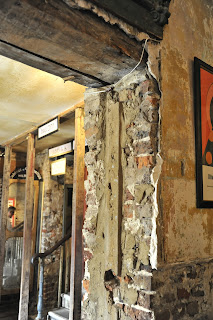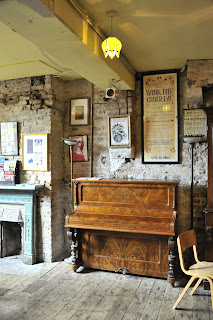In this essay I will discuss ideas in regards to the relationship between old and new building in modern environments. Using case studies, I will show the differences between the western culture of preserving and utilizing the old heritage in contrast replacing the old buildings with modern in China.
During my four years of study at China Academy of Art, I have learned that interior design is not simply about deciding how we arrange the furniture, but taking into consideration the people that inhabit this place, past memories of this place and the identity of it. More specifically I have been most interested in the idea of reusing and reconstructing of historical sites and old elements within the city. Thus I have done several projects that relate to old buildings. For example, reconstructing abandoned building and re-planning old block which was also my graduation project. Blow you can see the examples of it.
My graduation project was a challenge to me which related to urban planning. We worked as a 4-people-group. This project is to design and plan a cultural and commercial block in Beijing. It is a real project that our tutor's work team is doing. This block will have shopping malls, hotel, museums and cultural communication center. Even though the design might seem utopian and difficult to put in practice, we tried to combine our design with the traditional function and culture and linked it with the preexisting memories of this place. This project further development my ideas about the old buildings reconstruction.
With the technological and economical development of the modern society, building excessively is constantly reducing the already limited space in cities. For that some architects who pay attention to environment and culture in China see the value of reusing, protecting and repurposing the old buildings. (Y. Chang, 2010; S. Liang, 2011; S. Wang, 2012) The old buildings not only are the historical protected buildings, but also are the normal, less value and less protected old buildings. In my opinion, cities need old buildings.
With the technological and economical development of the modern society, building excessively is constantly reducing the already limited space in cities. For that some architects who pay attention to environment and culture in China see the value of reusing, protecting and repurposing the old buildings. (Y. Chang, 2010; S. Liang, 2011; S. Wang, 2012) The old buildings not only are the historical protected buildings, but also are the normal, less value and less protected old buildings. In my opinion, cities need old buildings.
Peter Eisenman said:
My work is a constant process of uncovering. Do not forget, there is no new history. The architects I
am going back to are all still there. They do not move. I move.[1]
am going back to are all still there. They do not move. I move.[1]
Also the famous Japanese architect Tadao Ando said:
You cannot simply put something new into a place. You have to absorb what you see around you, what exists on the land, and then use that knowledge along with contemporary thinking to interpret what you
see.[1]
It is important to return the cultural memory of the city and keep it alive for its people. Besides some degree of protection for the old buildings and districts, the old buildings also need revising, updating or modernizing. Reconstructing the old buildings can be done in many ways as soon as we keep their former characters.
Despite of the Chinese architects attempt the ideas, however in China there is still a big problem since the old buildings are not being appreciated both by governments and the Chinese people and they end up to be abandoned or replaced by modern ones. There is general belief that the financial development equals modern western buildings. Governments build modern buildings which will translate to financial development and remove large area of old buildings. The ways what governments do make the people think less about the old buildings heritage. (W. Chang, J. Xue, 2011;Y. Yang, 2012) Many old blocks became out of use even totally abandon because of less attention and managing from people. On the other hand, old buildings are get much more attention in London. Most of the old buildings still have different function today. London itself just likes a big library of architecture history. When you walk in a street in London, you strongly fell the English culture through the architectures. You can see many historical details in the buildings, you can live or work in them and enjoy their strong cultural feeling while they, at the same time, have the modern life. People in London enjoy and appreciate living in old buildings while Chinese people do not see the value of it.
This old block in China became totally abandoned after reconstructing failed. All the shops closed during the working hours.
In London, we can see the old block with new functions still be alive nowadays.
In the following sections I will review some case studies were old buildings have been reconstructed and repurposed in the western countries. For instance, the Italian architect name Gae Aulenti turned an old train station in Paris into one of the best art museums.
Musée d’Orsay
She connected the building with the environment of city and did full use of the original features of the building. In her design, she maintained the original museum's construction. At the same time, she took into consideration the relationship between the building and the cityscape. Aulenti views architecture as a concrete, untouchable entity that uses the city as its form generator. She sees architecture in terms of its relationship to the urban environment. In her designs, she blends the private with the public to generate architectural forms and spatial relationships. Aulenti believes that to create an effective domestic environment, architects must maintain the spatial elements and attributes that exist within a city. Accordingly, she attempts to design buildings in such a way that they share the complexity and density that exists within an urban atmosphere.(http://www.archiplanet.org/wiki/Gae_Aulenti, 08/2013)
British Museum
Norman Foster said:
As an architect you design for the present, with an
awareness of the past, for a future which is
essentially unknown.[2]
The central courtyard of British Museum
became out of use once upon a time. Norman Foster preserved the round reading hall of the former British
Library and redesigned the roof in using similar curves and glass to create a
light space. He
therefore took into consideration how the modern roof would integrate with the
old elements of the round reading hall. The shapes of the pieces of glass are
all different from each other because of the design of curving roof.
Wiltons
The Wiltons Music Hall is a unique
building comprising a mid-19th Century grand music hall attached to an 18th
Century terrace of three houses and a pub. It was old but it had the
special feel of nostalgia that made you feel comfortable when people were
inside. The details of this house was old or made to be looked like
old, like the stairs, the different types of furniture, the piano, the
lights, even the bricks on the walls were broken, they are still
beautiful. "This is the most
important surviving early music hall to be seen anywhere......It is of
outstanding architectural and archaeological significance." The
Theatres Trust.
Chelsea College of Art and Design
The college that I am going to learn is
also an example for reusing the old building. It was once called the name 45 Millbank,
dates back to the 1700s. That mill was replaced around 1736 with a house for
Sir Robert Grosvenor, demolished in 1809. The site was next occupied by the
greatest prison in Europe, the Millbank Penitentiary. Closed in the late 1800s,
the prison was demolished for the building of the Royal Army Medical College
and Regimental Mess. Today, this impressive Edwardian edifice is home to the
Chelsea College of Art and Design - and to 45 Millbank. Chelsea opened a new
public gallery where visitors to the campus can see cutting edge art and
design. Joint events are also staged with Tate Britain, which is next to
Chelsea College. The developing relationship of these two great art
institutions gives London an exciting cultural centre on Millbank. (http://45millbank.com/site-history,
08/2013)
Xintiandi·Shanghai
China has a famous successful case about reconstructing
old buildings. It is called Xintiandi. It is a walking street gathering dinning,
business, entertainment and culture based on the old buildings of the original
style of Shanghai Shikumen. The appearance of buildings has not changed from the
style of Shikumen, but the interior of the buildings became completely modern
lifestyle. Xintiandi combines the modern function with the old Chinese
buildings closely, shows the history of architecture in Shanghai. Now it has
become one of the landmarks in Shanghai. (S. He, F. Wu, 2005)
Buildings have lives and voice that are
worth listening to. (Littlefield, Lewis, 2007) Cities need old buildings.
Reusing the old buildings should be paid more attention. For the practical
element of workshop 3 I have to create a virtual museum that would bring
together my work with the work of other artists and theorists that think about
the same idea.
In my MA project I aim to further
investigate the relationship of old and new buildings and think of ways that
this culture of appreciating them can be applied in China. I will read a lot of
books about old and new architecture to help me to understand better about the
meaning of old buildings reconstruction. I collect a list of the bibliography
that can help me to learn.
- Architecture Reborn: The Conversion
and Reconstruction of Old Buildings
- Re/architecture: old buildings/ new
uses
- Down to Earth: Mud Architecture – An
Old Idea, A New Future
- Metaobolism, The City of Future:
[dreams and visions of reconstruction in post war and present-day, Japan]
- Re-forming British: Narratives of
Modernity Before Reconstruction
- Idea and Style; The Quest for Modern
Architecture
- Space In architecture: The Evolution
of A New Idea In The Theory and History of The Modern Movements
- When Culture Meets Architecture
- Architecture Culture, 1943-1968: A
Documentary Anthology
Besides, I will collect and analyze famous architects’
work in the world. I may do research from the material, structure,
cultural style or other respects of the old buildings. I can collect different
details of old architecture in London as much as I can, compare with the
details in China. The architecture is different because of the different
culture, so the ways of old buildings reconstruction do. I am willing to see
and learn different ideas and ways of old buildings reconstruction. The MA
project for me may not be a complete project for buildings. It can be presented
with a space made by different old and new materials to show the combination of
old and new, to find the best method of performing the old space in modern
ways.
References:
[1] L.S. Dushkes. The
Architect Says: Quotes, Quips, and Words of Wisdom (2012). Princeton
Architectural Press.
S. Cantacuzino. Re-Architecture: Old Buildings New Uses (1989). Abbeville Pr.
K. Powell. Architecture Reborn: The Conversion and Reconstruction of
Old Buildings (2005). New Line
Books.
R. Klanten, L. Feireiss. Build-on: Converted Architecture and Transformed
Buildings (2009). Die Gestalten Verlag.
Y. Chang, 2012. Materialism (2010). http://video.zhulong.com/play708789.html
(08/2013).
S. Liang. Chinese Architecture Art and
Artifacts (2011). Foreign Language Teaching and Research Press.
S. Wang. The Architect who is
anti-modernization (March 15th, 2012). Time Weekly.
W. Chang, J. Xue. (2011) Study Situation of
Chinese Contemporary Architectural Design. Journal
of Modern
Enterprise Education,
17, 25.
Y. Yang. The Deformity Status of Chinese
Architecture (May 23rd, 2012). People Digest.
[2] N. Foster. My Green Agenda for Architecture (2007). TED Talks.
S. He, F. Wu. (2005) Property-led redevelopment in post-reform
China: a case study of Xintiandi redevelopment project in Shanghai. Journal of Urban Affairs, 27, (1), 1-23.
D. Littlefield, S. Lewis. Architectural Voices (2007)
Wiley-Academy.

















.jpg)

没有评论:
发表评论